Derringer
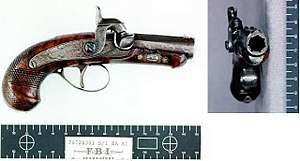
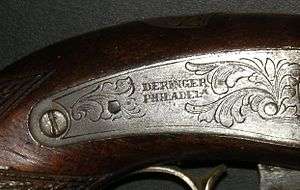
The term "derringer" has come to refer to any small-sized handgun that is neither a revolver nor a semiautomatic pistol, although mini-revolvers are commonly called derringers.
The original Philadelphia Deringer was a single-shot muzzleloading percussion cap pistol introduced in 1852, by Henry Deringer. In total, approximately 15,000 Deringer pistols were manufactured.[1] All were single barrel pistols with back action percussion locks, typically .41 caliber with rifled bores, and walnut stocks. Barrel length varied from 1.5" to 6", and the hardware was commonly a copper-nickel alloy known as "German silver".
The term "derringer" (/ˈdɛrɪndʒər/) has become a genericized misspelling of the last name of Henry Deringer.[1] Many copies of the original Philadelphia Deringer pistol were made by other gun makers worldwide, and the name was often misspelled; this misspelling soon became an alternative generic term for any pocket pistol, along with the generic phrase palm pistol, which Deringer's competitors invented and used in their advertising. With the advent of metallic cartridges, pistols produced in the modern form are still commonly called "derringers".[2]
Philadelphia Deringer
The Philadelphia Deringer was a small percussion handgun designed by Henry Deringer (1786–1868) and produced from 1852 through 1868. A popular concealed carry handgun of the era, this pocket pistol design was widely copied by competitors, sometimes down to the markings.[3]
For loading a Philadelphia Deringer, one would typically fire a couple of percussion caps on the handgun, to dry out any residual moisture contained in the tube or at the base of the barrel, to prevent a subsequent misfire. One would then remove the remains of the last fired percussion cap and place the handgun on its half-cock notch, pour 15 to 25 grains (1 to 2 g) of black powder down the barrel, followed by ramming a patched lead ball down onto the powder, being very careful to leave no air gap between the patched ball and the powder, to prevent the handgun from exploding when used. (The purpose of the patch on the ball was to keep the ball firmly lodged against the powder, to avoid creating what was called a "short start" when the ball was dislodged from being firmly against the powder.)
A new percussion cap would then be placed on the tube (what today would be called a nipple), and the gun was then loaded and ready to fire. (The half-cock notch prevented the hammer from falling if the trigger were bumped accidentally while carrying the handgun in one's coat pocket.) Then, to fire the handgun, a user would fully cock the hammer, aim, and squeeze the trigger. Upon a misfire, the user could fully re-cock the hammer, and attempt to fire the handgun once more, or, equally commonly, switch to a second Deringer. Accuracy was highly variable; although front sights were common, rear sights were less common, and some Philadelphia Deringers had no sights at all, being intended for point and shoot use instead of aim and shoot, across poker-table distances. Professional gamblers, and others who carried regularly, often would fire and reload daily, to decrease the chance of a misfire upon needing to use a Philadelphia Deringer.[4]

Henry Deringer's production records, and contemporaneous records of his imitators, indicate that these pistols were almost always sold in matching pairs. (A typical price was $15 to $25 for a pair, with silver-inlaid and engraved models selling at higher prices.) The choice of buying a pair, in part, was to compensate for the limited power of a single-shot, short-barreled pistol, and to compensate for a design considerably less reliable than subsequent cartridge derringer designs. Original Deringers are almost never found still in their matched pairs today.[1]
Initially popular with military officers, the Deringer became widely popular among civilians who wished to own a small and easily concealable pistol for self-defense.[4]
In total, approximately 15,000 Deringer pistols were manufactured.[1] All were single barrel pistols with back action percussion locks, typically .41" rifled bores, and walnut stocks. Barrel length varied from 1.5" to 6", and the hardware was commonly a copper-nickel alloy known as "German silver". The back action lock was a later, improved design among locks, which had its spring and mechanism located behind the hammer, where it was thereby protected from dirt, fired cap residue, and gunpowder residue, unlike earlier front action locks that had their springs and mechanism located directly in the path of such residue in front of the hammer, under the tube.[4]
Because of their small size and easy availability, Deringers sometimes had the dubious reputation of being a favored tool of assassins. The most famous Deringer used for this purpose was fired by John Wilkes Booth in the assassination of Abraham Lincoln. Booth's Deringer was unusual in that the rifling twisted counterclockwise (left-handed twist), rather than the typical clockwise twist used on most Philadelphia Deringers.[3]
Remington Derringer
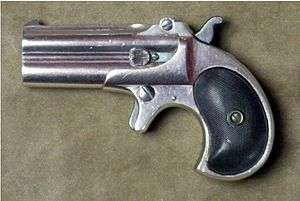
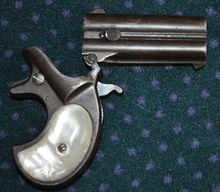
Remington Arms manufactured more than 150,000 Model 95 over-under double-barreled derringers from 1866 until the end of their production in 1935.[5][6] The gun was made only in .41 rimfire. The Remington derringer design doubled the capacity, while maintaining a compact size, by adding a second barrel on top of the first and pivoting the barrels upwards to reload. Each barrel then held one round, and a cam on the hammer alternated between top and bottom barrels. There were four models with several variations. The .41 Short bullet moved very slowly, at about 425 feet per second (130 m/s), around half the speed of a modern .45 ACP. It could be seen in flight, but at very close range, such as at a casino or saloon card table, it could easily kill.
The Remington Model 95 has achieved such widespread popularity that it has completely overshadowed all other designs, becoming synonymous with the word "Derringer". The classic Remington design remains popular with the advent of smaller, higher-powered smokeless powder cartridges. A Remington-pattern derringer in .38 Special is still smaller than the most compact .25 ACP semiautomatic, and provides superior terminal ballistic performance to the .25 ACP.
The Remington derringer design is still being manufactured by American Derringer and Bond Arms, both of which make derringers in a variety of calibers from .22 long rifle to .45 Long Colt and .410 bore.[7] The current production of derringers are used by Cowboy Action Shooting reenactors as well as a concealed-carry weapon.
Other designs
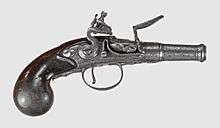
A derringer is generally the smallest usable handgun of a given caliber. It was frequently used by women, because it is easily concealable in a purse or as a stocking gun.[8] Such weapons designed specifically for women were called "muff pistols", due to their compact size enabling them to be carried in a muff.[4]
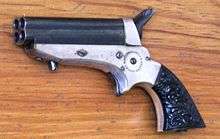
One of the more common derringers found in the "Old West" were the Sharps Derringers.[9] They are four-barrel, single-action derringers with a revolving firing pin. They come in .22, .30 and .32 rimfire, and their four barrels slide forward to load and unload. First patented in 1849, they were not made until 1859, when Sharps patented a practical derringer design. These first model derringers had brass frames and fired the recently introduced .22 Rimfire metallic cartridges. The second model was a .30 Rimfire derringer. The third model derringer was a .32 Rimfire, with an iron frame, and the barrel release was moved from under the frame to the left side of the frame. The fourth model derringer was also a .32 Rimfire with a new "birdshead" grip and slightly shorter barrels, otherwise it was virtually identical to the third model. Production of these little pistols came to an end with the death of Christian Sharps in 1874.
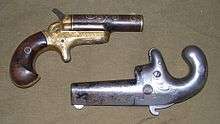
Daniel Moore patented a single shot metallic cartridge .38 Rimfire derringer in 1861. These pistols had barrels that pivoted sideways on the frame to allow access to the breech for reloading. Moore would manufacture them until 1865, when he sold out to National Arms Company, which produced single shot .41 Rimfire derringers until 1870, when it was acquired by Colt's Patent Firearms Manufacturing Company. Colt continued to produce the .41 Rimfire derringer after the acquisition, as an effort to help break into the metallic-cartridge gun market,[10] but also introduced its own three single shot Colt Derringer Models, all of them also chambered in the .41 Rimfire cartridge. The last model to be in production, the third Colt Derringer, was not dropped until 1912. The third Colt Derringer Model was re-released in the 1950s for western movies, under the name of Fourth Model Colt Deringer.
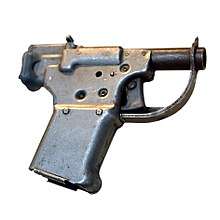
A military pistol that is truly a derringer design is the FP-45 Liberator, a .45 ACP insurgency weapon dropped behind Axis lines in World War II.[11] The FP-45 was a crude, single-shot pistol designed to be cheaply and quickly mass-produced. It had just 23 largely stamped and turned steel parts that were cheap and easy to manufacture. It fired a .45 caliber pistol cartridge from an unrifled barrel. Due to this limitation, it was intended for short range use, 1–4 yards (1–4 m). Its maximum effective range was only about 25 feet (8 m). At longer range, the bullet would begin to tumble and stray off course. Five extra rounds of ammunition could be stored in the pistol grip. The original delivered cost for the FP-45 was $2.10/unit, lending it the nickname "Woolworth pistol".[12]
While the classic Remington design is a single-action derringer with a hammer and tip-up action, the High Standard D-100, introduced in 1962, is a hammer-less, double-action derringer with a half-trigger-guard and a standard break action design. These double-barrel derringers were chambered for .22 Long Rifle and .22 Magnum and were available in blued, nickel, silver, and gold plated finishes. Although they were discontinued in 1984, American Derringer obtained the rights to the High Standard design in 1990 and produced a larger .38 Special version. These derringers, called the DS22 and DA38, are still made and are popular concealed carry handguns.
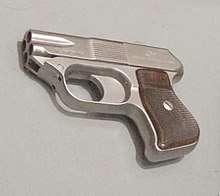

The COP 357 is a four-barrel, hammer-less, double-action, .357 Magnum derringer with the barrels stacked in a 2 × 2 block. Introduced in 1984, it's not much larger than a .25 ACP semi-automatic pistol, and was significantly smaller than a small frame revolver. A smaller caliber version the MINI COP in .22 Magnum was also made by American Derringers.
DoubleTap derringers are modern, hammer-less, double-action, double-barreled, large caliber derringers designed for personal protection and introduced by DoubleTap Defense in 2012.[13] They feature stainless steel ported barrels and aluminum or titanium alloy frames. They also hold two extra rounds in the grip. The name comes from the double tap shooting technique in which two rounds are quickly fired before engaging the next target.[14] Its makers have stated that they drew inspiration from the FP-45 Liberator pistol, which also held extra ammo in the grip.[15]
In popular culture
In Red River, dancehall girl Joanne Dru has dinner with John Wayne with a Remington Derringer concealed in the sling on her arm.
On the television series Gunsmoke (1955 – 74), Kathleen "Kitty" Russell (Amanda Blake) would produce various types of derringers as plots required.
Paladin, of Have Gun, Will Travel (1957 - 1963), kept a Remington Derringer behind his gunbelt's buckle as a holdout gun and made good use of it on many occasions.[16]
On the (1958-1959) television series of the same name, Yancy Derringer's weapons of choice were four-barrel Sharps Derringers. He carried three of them concealed: one held by a clamp inside the top of his hat, one in his vest's left pocket under his jacket and one up his jacket's left sleeve in a wrist holster.
In the "Judgment in Heaven" episode of The Big Valley (S01E15; 1965 Dec. 22), Jarrod Barkley gives Heath a nickel plated pearl gripped Remington Derringer as a Christmas present.
Remington Derringers often played critical roles in the exploits of James T. West, fictional Secret Service agent, in the American television series The Wild Wild West (1965 - 1969). West carried up to three derringers: one as a concealed carry backup gun to his holstered and openly carried full sized revolver. This derringer was carried either in a vest pocket or an inside pocket of his jacket. Another derringer was carried as a sleeve gun under his right shirt sleeve, and the third was broken into two parts with the barrel-chamber assembly hidden in the hollowed out heel of one boot and the frame hidden in the heel of the other.[17]
Two characters in the 1965 movie Cat Ballou wield derringers.
In Ian Fleming's novel The Man with the Golden Gun (1965), Francisco "Pistols" Scaramanga seriously wounds James Bond with his "tiny golden Derringer", seconds before Bond kills the thug with five shots from his Walther PPK 7.65 millimeter.
J.B. Books, portrayed by John Wayne, in The Shootist (1976), carried a Remington Derringer with his wallet.[16]
A single-shot Colt Derringer was the concealed weapon of choice for Buford "Mad Dog" Tannen in Back to the Future Part III (1990). He uses it to kill Dr. Emmett "Doc" Brown in a previous unseen-on-screen timeline. However, in the timeline seen in the movie, Tannen's attempt to kill Brown is thwarted when Marty McFly throws a pie plate at the Derringer in Tannen's outstretched hand. The gun discharges, hitting Brown's hat and knocking it off his head.[18]
In the 1995 anime Trigun, Meryl Strife hides under her white coat many derringer-style "throwaway" pistols, which she uses with extremely precise aim.
In the (2001) Simpsons episode "Simpsons Tall Tales" the characters Bart and Nelson are portrayed as Tom Sawyer and Huckleberry Finn. The two start a barroom brawl on a Mississippi river gambling boat, in which the bar patrons fire comically weak Derringer pistols. The bullets all bounce off glass bottles, glass beer mugs, glass windows and their intended victims and they escape unharmed.
In the 2002 remake of Resident Evil, a Derringer (or 'self defense gun') can be found in the Residence. It only has a single .22 Magnum round left in the chamber, and cannot be reloaded, but is powerful enough to kill almost any enemy in the game.
In The Matrix Reloaded (2003), Persephone uses a COP derringer.
In the TV show NCIS: Los Angeles (2009-present) Henrietta "Hetty" Lange (Linda Hunt) Uses a Remington Derringer.
In the movie Django Unchained (2012), a Colt Derringer sleeve gun is used by both Dr. King Schultz (Christoph Waltz) and Django (Jamie Foxx).
In the 2015 video game Assassin's Creed Syndicate, a Derringer pistol is seen many times in the game as a weak firearm, and is the first pistol in the game.
In the Aimee & David Thurlo Ella Clah novels, Ella's backup gun is a 2-shot Derringer she carries strapped to her ankle.
In The Aluminium Dagger by R. Austin Freeman a Derringer gun is used by the murderer to end his own life after being found out.
Musician and music producer Felix Pappalardi was shot and killed by his wife, Gail, on April 17, 1983, in their East Side Manhattan apartment, with a derringer he had given her as a gift a few months previously. Gail Pappalardi was subsequently charged with second-degree murder and was found guilty of the lesser criminally negligent homicide.
See also
Footnotes
- 1 2 3 4 Flayderman (2007)pp. 410-412
- ↑ Chapel, Charles Edward (19 September 2013). Guns of the Old West: An Illustrated Guide. Courier Dover Publications. pp. 104–106. ISBN 978-0-486-42161-2.
- 1 2 Russell, Carl Parcher (1 January 1980). Guns on the Early Frontiers: A History of Firearms from Colonial Times Through the Years of the Western Fur Trade. Omaha: U of Nebraska Press. pp. 138–139. ISBN 0-8032-8903-0.
- 1 2 3 4 Boorman, Dean K. (1 November 2004). Guns of the Old West: An Illustrated History. Globe Pequot Press. pp. 28–35. ISBN 978-1-59228-638-6.
- ↑ "Remington .41 Double Derringer". American Rifleman. March 24, 2014. Retrieved 2017-07-22.
- ↑ Marcot, Roy M. (2005). The History of Remington Firearms. Lyons Press. p. 32. ISBN 978-1-59228-690-4.
- ↑ Ramage, Ken (5 August 2008). Gun Digest 2009: The World's Greatest Gun Book. Iola, Wisconsin: F+W Media, Inc. p. 308. ISBN 0-89689-647-1.
- ↑ Carter, Gregg Lee (1 January 2002). Guns in American Society: An Encyclopedia of History, Politics, Culture, and the Law. ABC-CLIO. p. 159. ISBN 978-1-57607-268-4.
- ↑ "Guns of the New West". Retrieved 13 February 2016.
- ↑ Rick Sapp (2007). Standard Catalog of Colt Firearms. F+W Media, Inc,. pp. 59–60. ISBN 978-0-89689-534-8.
- ↑ Thompson, Leroy (2012). The Colt 1911 Pistol. Osprey Publishing. p. 99. ISBN 978-1-84908-836-7.
- ↑ Thompson, Leroy (3 May 2011). The Colt 1911 Pistol. Bloomsbury Publishing. p. 87. ISBN 978-1-84908-836-7.
- ↑ S., Jeremy (2013-07-01). "Gun Review: DoubleTap Tactical Pocket Pistol". The Truth About Guns. Retrieved 2016-09-05.
- ↑ "Frequently Asked Questions". Heizer Defense LLC. Archived from the original on 14 October 2012. Retrieved 22 December 2012.
- ↑ "Announcement". Heizer Defense LLC. 7 November 2012. Retrieved 22 December 2012.
- 1 2 "Little Guns". American Rifleman. March 7, 2012. Retrieved 2017-07-22.
- ↑ Biederman, Danny (14 October 2004). The Incredible World of Spy-fi: Wild and Crazy Spy Gadgets, Props, and Artifacts from TV and the Movies. Chronicle Books. p. 67. ISBN 978-0-8118-4224-2.
- ↑ Fhlainn, Sorcha Ní (12 May 2010). The Worlds of Back to the Future: Critical Essays on the Films. McFarland. p. 100. ISBN 978-0-7864-5765-6.
References
Flayderman, Norm (3 December 2007). Flayderman's Guide to Antique American Firearms and Their Values. Iola, Wisconsin: Gun Digest Books. ISBN 1-4402-2651-2.
External links
| Wikimedia Commons has media related to Deringers. |
| Look up derringer in Wiktionary, the free dictionary. |
- The Booth Deringer--Genuine artifact or Replica?, a report of an FBI analysis of the Booth Deringer, made after rumors that the original had been stolen and replaced with a replica.
- Derringer